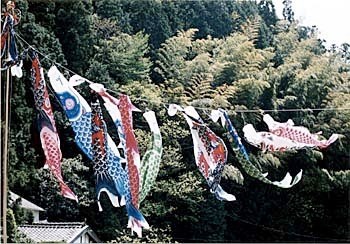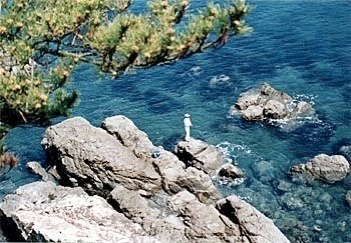































Shikoku is the smallest of Japan's four main islands, and the lack of any really spectacular tourist attractions (such as Mt. Aso on Kyushu, Shiretoko on Hokkaido or, of course, the entire city of Kyoto on Honshu) keeps it off the itineraries of most visitors. It definately shouldn't be kept off KANcycling, however, since the island offers lots of great mountain, river and seacoast cycling. If you're coming from Honshu, you'll probably begin from either Tokushima or Takamatsu, the regional cities with busy ferry ports on the northeast coast. Routes from either city lead eventually to the southern city of Kochi: Route 1 goes along the coast from Tokushima, while Route 2 goes down through the center of the island from Takamatsu. Route 3 is a sort of hybrid, starting from Tokushima but including most of the same sites as Route 2.. On my first trip, I arrived at the beginning of May, as these Children's Day carp streamers demonstrate.
Route One starts at Tokushima - or Naruto, if you want to detour to the famous Naruto Whirlpool. It can be seen at high tide twice a day, either by boat or from an observation tower on the hill (Tsujigaoka). Note that bicycles aren't permitted on the Naruto Bridge, so you can't see it from there. I settled for less spectacular shoreline scenery like this. Initially it takes quite awhile to get to the coast (an indicator of how rugged that coast really is); eventually, around the Anan area, you start to get views like this. There's actually a Japanese word for "white sand and green pine" that sums up what the Japanese coastline used to look like; as this photo shows, parts of it still do).



